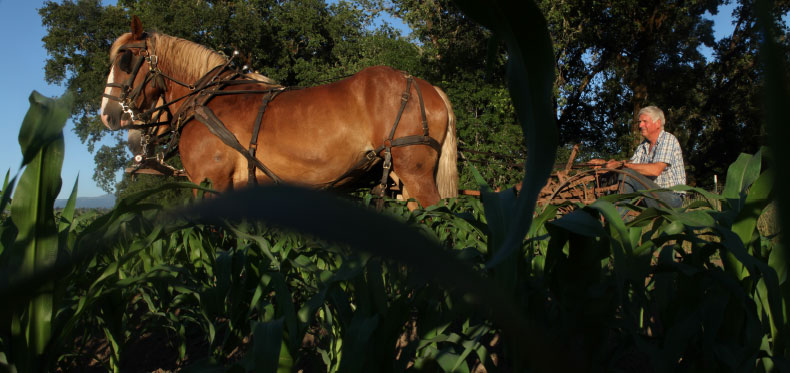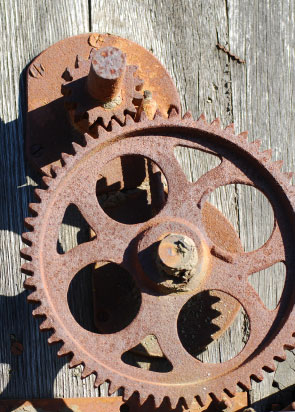The farm is designed to operate on solar rather than fossil energy. Farm energy goals include creating our farming inputs from within the farm organism, including fertilizer, feed, and energy.
The use of draft horses for field power engenders a particular scale and diversity in the farm, which makes farming dynamics and natural relationships more visible and easily comprehended. Our six work horses are used for plowing, spreading compost, harrowing, planting, cultivating, mowing, raking, and transportation within the farm. We make approximately 50 tons of biodynamic compost each year from the combined manures of our livestock, weed and crop residues, and straw, and do not import compost from outside the farm. About 2 acres of the farm are planted annually to oats, barley, wheat, field corn, beans, and other small grains for feeding the chickens, pigs, and work horses. We are gradually replanting and improving hay and pasture fields. Our annual hay requirement is about 60 tons, which we harvest mostly from perennial grass pasture fields, 4 ac. of irrigated clover and alfalfa, and some annual hay plantings of peas and oats or rye and vetch. Through replanting and irrigating our existing fields and will reach our goal of completely eliminating the need to import feed from outside the farm.
An 28-kw photovoltaic (PV) system provides much of our electrical power and currently heats a percentage of our hot water. The PV system, mounted on the barn and adjacent buildings, is currently grid tied. The power generated is used for lighting, refrigerators and freezers, shop tools, 6 hp of water pumping, and electric water heating. We have acquired and will install flat-plate thermal collectors and a drainback tank to expand the capacity of our existing solar hot water components, enabling us to get rid of the electric water heaters. This will free PV electricity for other needs. We have converted an Allis Chalmbers G tractor from gas to 48 vdc electric which is used mostly for transport in the farm when the horses are not in harness. We are planning to build a fore cart for the horses to pull that will have a portable battery bank and electric motor PTO to power our baler and grain combine. This cart will also be a mobile power source for running power tools, an electric chain saw, water pumping, and other needs in the field, and will be recharged from the PV system. We plan to install an additional 5hp of water pumping and increase the PV system by 5 to 10-kw to cover the expanded water pumping and EV use which will mak e us largely energy self-sufficient within the farm.



